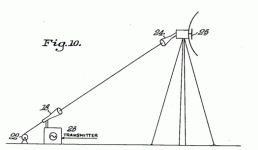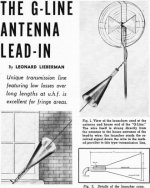- Joined
- Jun 13, 2018
- Messages
- 869
.
I have been meaning to write up this unusual topic for some time. Then a weather event this week brought it back in sharp focus with a snow storm and high winds. All night long this storm raged, and in the morning I was greeted by its twisted mass buried in a snow bank.
Caught your attention ? Well the twisted mess was a 600 foot run of #10 insulated wire that runs (ran ) from the peak of a barn up to the top of a towering granite escarpment that over-shadows my house. That escarpment was a wonderful shield against the elements for my great grand parents, but they built it long before there was any radio. It effectively puts me in a great semi-Faraday mountain cage for anything to the north.
) from the peak of a barn up to the top of a towering granite escarpment that over-shadows my house. That escarpment was a wonderful shield against the elements for my great grand parents, but they built it long before there was any radio. It effectively puts me in a great semi-Faraday mountain cage for anything to the north.
That said, if I wanted to access any of the V/UHF ham repeaters in the valley to the north I would have to use a high gain antenna, swing it about to find the hot-spot on a mountain side --and bounce a signal out of my shadow.
I had thought of running a coax line up to the top of that escarpment, and put a beam up there, but the cable length with its feed line losses made that prohibitive.
Ah ! but what better reason to try a novel feedline- a Goubau line- than my "escarpment."
Better known as a "G-Line" (and no, that is not a "G-String" )- this feed line has been around since radio's beginnings. Yet it has been lost to time, at least to hams.
)- this feed line has been around since radio's beginnings. Yet it has been lost to time, at least to hams.
What is a G-Line ? ***

Simply put, its a single run of wire with two 'launchers' placed at both ends; it acts as a waveguide, and it is very effective at V/UHF frequencies. What is neat about this feed line is its extremely low losses--- while coax can be rated at so many dB's-loss per hundred feet, a G-Line is rated at so many dB's-loss per mile! ........The down size is they are just, really, mechanically, awkward..... This, making it pretty much a specialty item. But if its a situation requiring a lonnnng feed line run..........
In my case I was in luck to have some fellows at the machine shop at my lab fabricate the two launching horns for me. It took a bit of searching for the correct wire, for the dielectric on this wire acts much the same way to effect the forward wave like the earth's effect on low frequency "ground wave" signals.
The 'horns' terminate in standard 75 Ohm coax that feeds both the radio and a three-element commercial grade, wide bandwith beam.
We strung (and are going to have to re-string) -the wire by pulling it (Carefully!) taught with a tractor. It can tolerate some sagging, but it really wants to be straight. Sharp bends in the wire will induce losses, and also become radiation hot spots..
How does it work ?
Is Awesome a good technical term ?
_______________________________________________________________________________________________________________________________________________________-
I have no dB loss figures for this 600 foot run, but signals that were barely above the noise floor at the house (unless a beam was pointed at a mountain side as a passive repeater) -are 'full quieting" at the other end of the 'horn.'
Looking for an interesting project?
Lauri

*** The 'G-Line' Community TV System, November 1956 Radio & Television News
.
I have been meaning to write up this unusual topic for some time. Then a weather event this week brought it back in sharp focus with a snow storm and high winds. All night long this storm raged, and in the morning I was greeted by its twisted mass buried in a snow bank.
Caught your attention ? Well the twisted mess was a 600 foot run of #10 insulated wire that runs (ran
That said, if I wanted to access any of the V/UHF ham repeaters in the valley to the north I would have to use a high gain antenna, swing it about to find the hot-spot on a mountain side --and bounce a signal out of my shadow.
I had thought of running a coax line up to the top of that escarpment, and put a beam up there, but the cable length with its feed line losses made that prohibitive.
Ah ! but what better reason to try a novel feedline- a Goubau line- than my "escarpment."
Better known as a "G-Line" (and no, that is not a "G-String"
What is a G-Line ? ***

Simply put, its a single run of wire with two 'launchers' placed at both ends; it acts as a waveguide, and it is very effective at V/UHF frequencies. What is neat about this feed line is its extremely low losses--- while coax can be rated at so many dB's-loss per hundred feet, a G-Line is rated at so many dB's-loss per mile! ........The down size is they are just, really, mechanically, awkward..... This, making it pretty much a specialty item. But if its a situation requiring a lonnnng feed line run..........
In my case I was in luck to have some fellows at the machine shop at my lab fabricate the two launching horns for me. It took a bit of searching for the correct wire, for the dielectric on this wire acts much the same way to effect the forward wave like the earth's effect on low frequency "ground wave" signals.
The 'horns' terminate in standard 75 Ohm coax that feeds both the radio and a three-element commercial grade, wide bandwith beam.
We strung (and are going to have to re-string) -the wire by pulling it (Carefully!) taught with a tractor. It can tolerate some sagging, but it really wants to be straight. Sharp bends in the wire will induce losses, and also become radiation hot spots..
How does it work ?
Is Awesome a good technical term ?
_______________________________________________________________________________________________________________________________________________________-
I have no dB loss figures for this 600 foot run, but signals that were barely above the noise floor at the house (unless a beam was pointed at a mountain side as a passive repeater) -are 'full quieting" at the other end of the 'horn.'
Looking for an interesting project?
Lauri

*** The 'G-Line' Community TV System, November 1956 Radio & Television News
.





